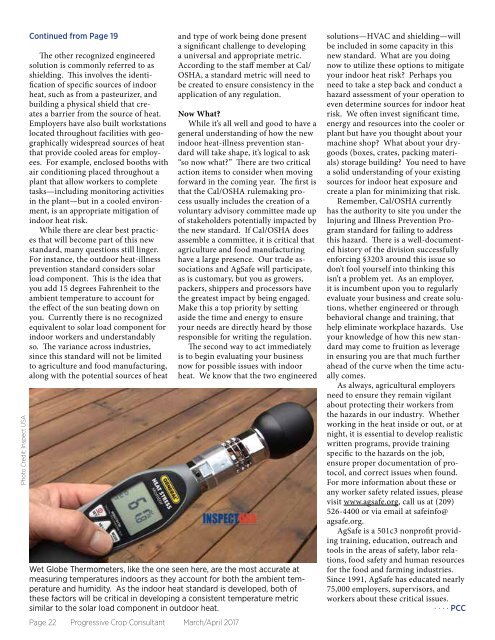Mar_Apr_PCC_2017_Web
Create successful ePaper yourself
Turn your PDF publications into a flip-book with our unique Google optimized e-Paper software.
Photo Credit: Inspect USA<br />
Continued from Page 19<br />
The other recognized engineered<br />
solution is commonly referred to as<br />
shielding. This involves the identification<br />
of specific sources of indoor<br />
heat, such as from a pasteurizer, and<br />
building a physical shield that creates<br />
a barrier from the source of heat.<br />
Employers have also built workstations<br />
located throughout facilities with geographically<br />
widespread sources of heat<br />
that provide cooled areas for employees.<br />
For example, enclosed booths with<br />
air conditioning placed throughout a<br />
plant that allow workers to complete<br />
tasks—including monitoring activities<br />
in the plant—but in a cooled environment,<br />
is an appropriate mitigation of<br />
indoor heat risk.<br />
While there are clear best practices<br />
that will become part of this new<br />
standard, many questions still linger.<br />
For instance, the outdoor heat-illness<br />
prevention standard considers solar<br />
load component. This is the idea that<br />
you add 15 degrees Fahrenheit to the<br />
ambient temperature to account for<br />
the effect of the sun beating down on<br />
you. Currently there is no recognized<br />
equivalent to solar load component for<br />
indoor workers and understandably<br />
so. The variance across industries,<br />
since this standard will not be limited<br />
to agriculture and food manufacturing,<br />
along with the potential sources of heat<br />
Page 22 Progressive Crop Consultant <strong>Mar</strong>ch/<strong>Apr</strong>il <strong>2017</strong><br />
and type of work being done present<br />
a significant challenge to developing<br />
a universal and appropriate metric.<br />
According to the staff member at Cal/<br />
OSHA, a standard metric will need to<br />
be created to ensure consistency in the<br />
application of any regulation.<br />
Now What?<br />
While it’s all well and good to have a<br />
general understanding of how the new<br />
indoor heat-illness prevention standard<br />
will take shape, it’s logical to ask<br />
“so now what?” There are two critical<br />
action items to consider when moving<br />
forward in the coming year. The first is<br />
that the Cal/OSHA rulemaking process<br />
usually includes the creation of a<br />
voluntary advisory committee made up<br />
of stakeholders potentially impacted by<br />
the new standard. If Cal/OSHA does<br />
assemble a committee, it is critical that<br />
agriculture and food manufacturing<br />
have a large presence. Our trade associations<br />
and AgSafe will participate,<br />
as is customary, but you as growers,<br />
packers, shippers and processors have<br />
the greatest impact by being engaged.<br />
Make this a top priority by setting<br />
aside the time and energy to ensure<br />
your needs are directly heard by those<br />
responsible for writing the regulation.<br />
The second way to act immediately<br />
is to begin evaluating your business<br />
now for possible issues with indoor<br />
heat. We know that the two engineered<br />
Wet Globe Thermometers, like the one seen here, are the most accurate at<br />
measuring temperatures indoors as they account for both the ambient temperature<br />
and humidity. As the indoor heat standard is developed, both of<br />
these factors will be critical in developing a consistent temperature metric<br />
similar to the solar load component in outdoor heat.<br />
solutions—HVAC and shielding—will<br />
be included in some capacity in this<br />
new standard. What are you doing<br />
now to utilize these options to mitigate<br />
your indoor heat risk? Perhaps you<br />
need to take a step back and conduct a<br />
hazard assessment of your operation to<br />
even determine sources for indoor heat<br />
risk. We often invest significant time,<br />
energy and resources into the cooler or<br />
plant but have you thought about your<br />
machine shop? What about your drygoods<br />
(boxes, crates, packing materials)<br />
storage building? You need to have<br />
a solid understanding of your existing<br />
sources for indoor heat exposure and<br />
create a plan for minimizing that risk.<br />
Remember, Cal/OSHA currently<br />
has the authority to site you under the<br />
Injuring and Illness Prevention Program<br />
standard for failing to address<br />
this hazard. There is a well-documented<br />
history of the division successfully<br />
enforcing §3203 around this issue so<br />
don’t fool yourself into thinking this<br />
isn’t a problem yet. As an employer,<br />
it is incumbent upon you to regularly<br />
evaluate your business and create solutions,<br />
whether engineered or through<br />
behavioral change and training, that<br />
help eliminate workplace hazards. Use<br />
your knowledge of how this new standard<br />
may come to fruition as leverage<br />
in ensuring you are that much further<br />
ahead of the curve when the time actually<br />
comes.<br />
As always, agricultural employers<br />
need to ensure they remain vigilant<br />
about protecting their workers from<br />
the hazards in our industry. Whether<br />
working in the heat inside or out, or at<br />
night, it is essential to develop realistic<br />
written programs, provide training<br />
specific to the hazards on the job,<br />
ensure proper documentation of protocol,<br />
and correct issues when found.<br />
For more information about these or<br />
any worker safety related issues, please<br />
visit www.agsafe.org, call us at (209)<br />
526-4400 or via email at safeinfo@<br />
agsafe.org.<br />
AgSafe is a 501c3 nonprofit providing<br />
training, education, outreach and<br />
tools in the areas of safety, labor relations,<br />
food safety and human resources<br />
for the food and farming industries.<br />
Since 1991, AgSafe has educated nearly<br />
75,000 employers, supervisors, and<br />
workers about these critical issues.<br />
· · · · <strong>PCC</strong>


















